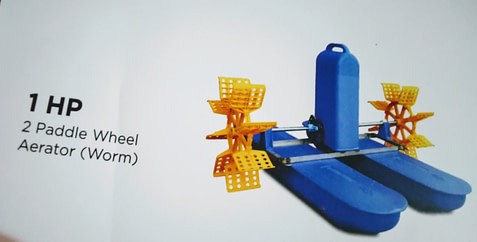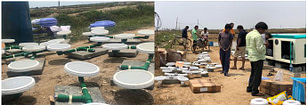Aeration
Aeration
Aeration brings water and air in close contact in order to remove dissolved gases (such as carbon dioxide) and oxidizes dissolved metals such as iron, hydrogen sulfide, and volatile organic chemicals (VOCs).
Aquaculture pond aeration is vital to the vigorous health and vitality of fish. Without enough oxygen, fish become stressed and their growth rate slows. Additionally, the lack of oxygen at the bottom of the pond will allow the build-up of fish waste and other organic nutrients.
Standard Aerators
Fundamentals of Pond Aeration
• Have you seen Aquatic animal Fish/Shrimp gasping for Oxygen at the top of the Pond ?
• Are You having unsightly Algae Problems in Your Pond?
• Are you encountering thermal Stratisigication in your Pond?
“Yes” to above is due to deficient Oxygen Level in your Pond.
Next to feed, oxygen is the most important factor for determining the success of an aquaculture enterprise. Sufficient quantities of oxygen in the water ensure that the fishes grow well and stay healthy. Oxygen encourages their appetites and general well-being. It can even lessen the impact of temperature induced stress. That is why all fish farmers take particular care that their fishes grow under optimal O2 conditions.
Then go for appropriate Aeration to improve the Water Quality of the Pond.
What is “ Aeration” ?????????
Adding AIR to the Water, as Air content 22% of Oxygen, perfect aeration will enrich Pond with Oxygen.
Ponds with 6’ depth and induced Pollutions, are not capable of generating Significant Level Oxygen
Pond bottom can be compared with Human Stomach.
• When Pond Bottom Detoriates, It cannot support the Animal health.
• The bottom where abundant Oxygen is used,Called as Eutrophication Zones will run out of Oxygen First, and will be difficult to replenish from the top as it is farthest.
• The absence of Oxygen will Kill the dwelling animals thus amounting to Losses.
• Nutrients out of Fish/Shrimp Waste Faecal matters, Feed Wastages, Dead Algae’s, etc contributes heavily to negative parameter of water/Pond Bottoms. These accumulated radicals forms the layer of MUCK which serves as the Fertilizers for weed & Algae.
The above Problems can be addressed through appropriate aerations.
Types of Aeration:
Paddel Wheel Aerator:
Paddlewheel aerators swirl the water in the air, breaking it into as tiny droplets as possible to ensure a maximum contact area for gas exchange.
Oxygen is a fundamental prerequisite for the life of the vast majority of organisms. Respiratory gas plays a part in many processes that take place in the cells and tissues of the body. These processes involve complex chemical reaction chains whose individual steps often require oxygen. A key process that supplies the body with vital energy for muscle and nerve activity, growth, and other tasks, is “biological oxidation”, also called “internal respiration”. During this process the substances from the food that an organism has absorbed gradually “burn” within enzymatically controlled reaction chains and store the released energy in a chemical compound (ATP). This process is similar to charging a battery that can release its energy later on as required. To keep biological oxidation going, however, there must always be enough oxygen available in the body cells. Because the cells inside the body do not have direct access to the oxygen in the air, all higher organisms develop special respiratory organs (e.g. lungs, trachea or in the case of fish, gills), via which respiratory air can enter the body and be transported and distributed by the blood stream. In contrast to the internal respiration of the body’s cells, this oxygen intake, which occurs in fish mainly via the gills, is referred to as “external respiration”.
In shrimp farms the paddlewheel aerators are positioned so that they produce a rotating movement of water in the pond and prevent thermal stratification.
While terrestrial animals hardly have problems to gain sufficient oxygen from the air (the oxygen content in the atmosphere is about 20.95%), fishes have to expend much more energy on breathing. Water is 700 times denser and contains 30 times less oxygen than air. In order to ensure that there is a constant water current flowing past the gill filaments the fish has to use one third of its resting metabolic rate or, during strong swimming activity, even up to half, for breathing. Human beings seldom use more than 3%. Thus, a considerable part of the energy generated by the fish with the help of the oxygen it has absorbed is ultimately again used for breathing itself. In air breathers the ratio of ventilated air volume to the amount of blood that the heart pumps through the lungs is about 1 to 1. In fishes, it is approximately 16 to 1, however! The ventilation rate of the gill cover depends mainly on the species, its way of life, and the oxygen content of the water. When resting, a salmon moves its gill cover 60 to 70 times per minute but when swimming the frequency can increase to 150 / min. Flatfish that usually lie motionless on the seabed breathe only 30 to 40 times per minute. Fish that swim continuously such as mackerel and tuna have a comparatively small gill chamber. For them, the ventilation of the gill cover alone is not sufficient to supply their bodies with enough oxygen. If a mackerel is ecclosed in a small tank that does not have room for it to swim it will suffocate because even in 100% oxygen saturated water it can only enrich its blood with 11% oxygen. These species use the water current that flows past their gills for breathing. Other pelagic species, too, make use of this energy-saving technique as soon as their swimming velocity exceeds 35 cm / s.
Why Aerolake?
- Oxygenates by circulating entire water column
- Generates beneficial bacteria growth, Prevents fish kills due to lack of Oxygen
- Reduces associated algae growth
- Muck reduction in bottom by Oxidation Enhances oxygenated habitat for improved yield
- Controls aquatic midge and mosquito insect hatches
- De-odorize from undesirable dissolved gases extremely energy efficient.
- Virtually reduces power usage to 1/10th
How Aerolake Works :
- AEROLAKE have developed a pond aeration system that is proven to successfully increase oxygen levels in pond water and naturally improve the health of a pond. A properly designed system can help increase fish growth and health, reduce odours, nutrients, and muck, increase clarity and create a healthier aquatic ecosystem.
- AEROLAKE will take care of Thermal Stratification by Oxygenating and maintain the Dissolved Oxygen level throughout the Pond, especially at the dead bottom – Eutrophication zone.
- AEROLAKE will regulate the Temperature by Moderate Chilling during summer and Warming up during winter. This regulated condition will make the animal comfortable enough to grow rapidly.
- AEROLAKE is equipped with auto Dosing system to treat the Pond with day to Day Probiotic/Chemo/Bio-Cultures.
- AEROLAKE increases the process of oxidizing or eliminating pollution.
- AEROLAKE systems work by using special equipment for Laminar flow. This system adds dissolved oxygen to the pond which improves water quality, allowing aerobic bacteria to decompose organic matter which will naturally reduce pond weeds.
- AEROLAKE use special diffusers which generates Micro fineBubbles. Less the Bubble size, OTR- Oxygen transfer rate will increase drastically to increase oxygen levels in the most efficient manner.
Major KEY Benefits:
- Yield increased by 35-40%. Using Aerolake we can increases stoking.
- Thermo Regulation: State of art Air Management to regulate inflow temperature thus contributing to recommended temperature to the Pond, resulting Harvesting of two Crop in year in North India.
- Reduce DOC (Days of culture) by 35 to 40 days.
- Power consumption is 1/10 in comparison of traditional aeration.
Actual Sites Installation: Village-Patla- Ghaziabad Location:
.png)





